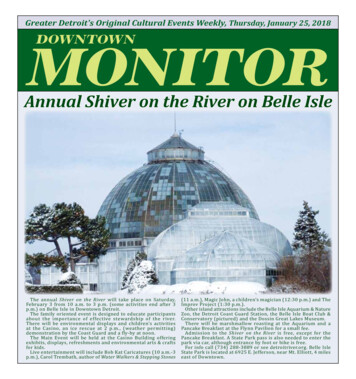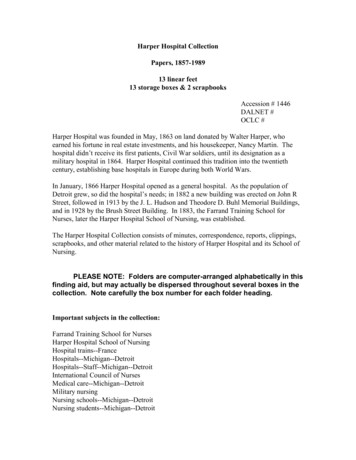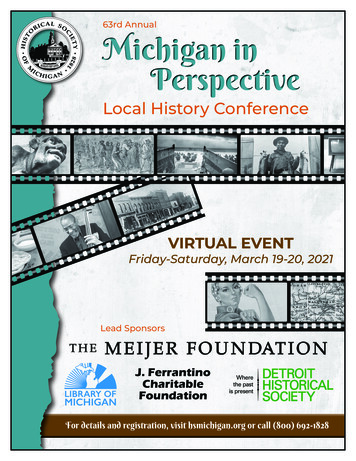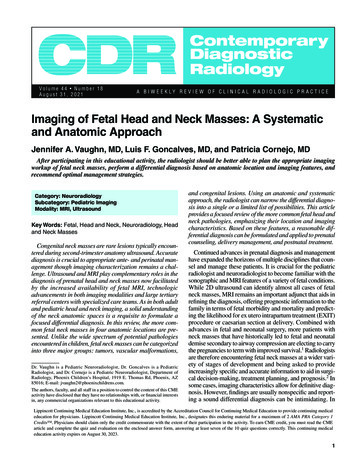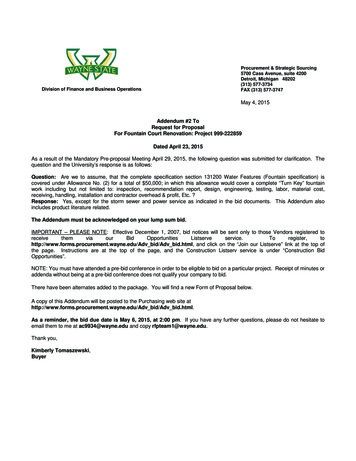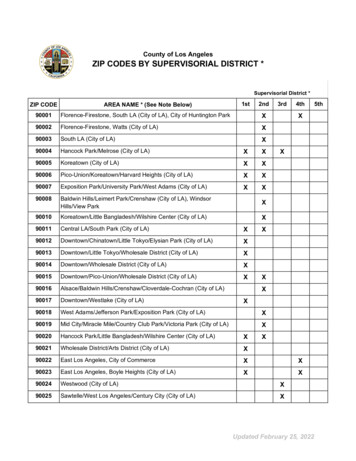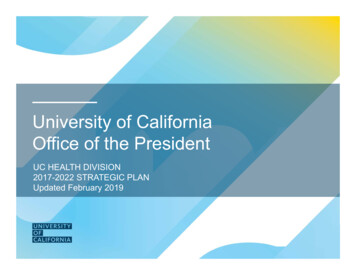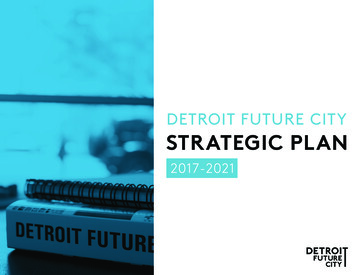
Transcription
DETROIT FUTURE CITYSTRATEGIC PLANCorporate F/A/C/T/S1
INTRODUCTIONIn 2010, an ambitious effort was launched to re-imaginea better future for Detroit.The Detroit Future City framework developed a seriesof ideas, strategies and approaches on how to best useour abundance of land, create job growth and economicprosperity, ensure vibrant neighborhoods, build aninfrastructure that serves citizens at a resonable costand maintain a high level of community engagementthat is integral to success.The DFC Strategic Framework articulates a shared visionfor Detroit’s future and recommends specific actions fordeveloping a vibrant and sustainable city.Corporate F/A/C/T/S2
DETROIT FUTURE CITYDetroit Future City, as a formalorganization, was created tochampion the framework as a livingdocument, help Detroiters understandand access the plan and coordinatetargeted projects and partnerships toimplement the strategies espoused inthe plan.The 2017-2021 DFC strategic plancrystalizes the strategies theorganization will lead to move theframework forward. The strategic planfocuses on four key areas driven by keyprinciples and shared values.Land Use and City SystemsDFC will design and implement strategies to address vacant lots at theneighborhood level, advance the design of a City-wide open space plan andidentify options for holding land for future public purposes for development.We will also connect residents to green storm water infrastructureinvestments, resiliency improvements and to participate in future land usedecision-making.Community and Economic DevelopmentDFC will lead the design of a city-wide service delivery system to address thedevelopment and management of the City’s growing single family rentalhousing stock, support the city’s commercial corridor revitalization strategyand develop pioneering approaches for the adaptive reuse of obsoleteindustrial sites.Keeping the DFC strategy fresh and relevantDFC will continue to engage the broader community, promote new ideas,bring best practice research and innovative approaches that keeps theframework integral to Detroit’s growth.Organizational capacityThis strategy also invests in DFC’s organization capacity and secure theresources necessary to achieve our mission.Corporate F/A/C/T/S3
PRIORITY AREASCOMMUNITY ENGAGEMENTCORE PRINCIPLESRACIAL EQUITY COREPRINCIPLESAlign and connect to the City’sneighborhood engagementinfrastructure for communityengagement.Ensure that DFC programs, policiesand strategies equitably benefitpeople and businesses of color andconnects them to the mainstreameconomy.Connect Detroiters to DFC innovationand strategies through the city andnon-profit organization network.SHARED VALUESCreate shared value relationshipswith the City and other keystakeholders which will shape DFC’srole in the revitalization of Detroit.We are excited about our new strategic plan and the opportunity to make Detroit Future City a reality!Corporate F/A/C/T/S4
MISSION AND CORE VALUESMISSION STATEMENTDFC is committed to advancing the quality of life forall Detroiters. We accomplish this in partnership withresidents, public and private stakeholders throughevidence-based strategies to promote innovative landuse, sustainable infrastructure, and economically vibrantDetroit neighborhoods.CORE VALUESAspirational: Steward of the Detroit Future City long termvision for Detroit.Transformative: Bring innovative practices, policies andsystems to the revitalization of Detroit.Inclusive: Integrate civic awareness and communityparticipation into DFC initiatives.Equitable: Ensure racial equity is a cornerstone to thedevelopment of the City.Corporate F/A/C/T/S5
LAND USE AND SUSTAINABILITY“Landscape has enormous potential to structure or foster social and cultural relationships through adapted and productiveecologies thatwill give rise to a new urban form.” - Detroit Future CityOverview:There are over 120,000 vacant lots within the city ofDetroit. While there is movement to create an integratedopen space network within the city of Detroit, thereis still much work to do to connect residents with thebenefits of open space within the city.DFC will help connect Detroiters with others workingtowards a future of local resiliency. This will be donethrough the continued convening a broad base ofstakeholders as part of the Open Space Working Group.Building toward implantation of an open space networkthe engagement of residents is an integral part of theprocess and the creation of a green culture shift can leadto a more informed and engaged public on the benefitsof open space in the city of Detroit.DFC is working toward a future where residents andinstitutions are actively involved with stewarding thecity’s vacant land into an integrated open space networkthat will help make Detroit the greenest city in America.To better outline this future a ‘Green Innovation Team’,composed of local and national experts, will be convenedto advise and identify opportunities and needs to createthe greatest benefits for residents.Corporate F/A/C/T/SGoal: Open Space: Advance Open Space as a land use in Detroit by: Influencing or enacting at least one (1) policy change Identify public/private partnerships (at least one largepartnership in a specified innovation area) 2-3 publications on green stormwater and open spaceStrategies:Year One Conduct research related to open space plan implementation Convene Open Space Working Group to support the open spaceplanning process, member led research/initiatives and communityengagementYears Two and Three Green Culture Shift – Campaign to change perceptions andencourage widespread implementation of Public Lands FrameworkPlan and Sustainability Action Agenda by all stakeholders Convene ‘Green Innovation Team’ to help guide and identify futurestrategy.Years Four and Five Execute strategies that emerge from best practice research or landuse studies.6
LAND USE AND SUSTAINABILITY“Landscape has enormous potential to structure or foster social and cultural relationships through adapted and productiveecologies that will give rise to a new urban form.” Detroit Future CityOverview:Water is a flashpoint topic as concerns rise over quality,costs, and extreme weather events leading to drought insome areas and flooding in others. These challenges arecomplex, and in Detroit are further complicated by thewater system’s crumbling infrastructure.Combined Sewer Overflows (CSO) and Sanitary SewerOverflows (SSO) pollute local rivers several dozen timesper year on average, far in excess of state and nationalclean water standards. Heavy rainfalls also causeflooding, which shuts down roads, damages personalproperty, interrupts business, and threatens humanhealth and safety.As DWSD updates their billing system to distribute thecost of drainage across the city based on imperviousnessacreage, there is the opportunity to mitigate a portionof the drainage fee by implementing green stormwaterinfrastructure. DFC will promote implementation of GSIas a component of an integrated open space network.Business owners, non-profits, faith based organizationsand residents can play a pivotal role in divertingstormwater from the CSO system which has the potentialto prevent basement flooding and provide co-benefits fortheir community. DFC will take an active role to ensurethe most vulnerable neighborhoods andresidents are prepared to participate in these solutions.Corporate F/A/C/T/SGoal: Green Stormwater Infrastructure: Achieve a common goalamong the eco-system of Detroit NGOs to reduce stormwateroverflows: Quantifiable amount of gallons of water reduced from thesystem (combined stormwater/sewer overflow system) 2-3 publications on green stormwater infrastructure andopen space Quantifiable measurement of the economic impact of GSI Design and implement a new financing strategy for triplebottom line benefitsStrategies:Year One Establish partnership with the Nature Conservancy for conveningBlue Green Infrastructure Working Group Lead ‘Land Water Works’ Campaign to educate residents on thestormwater fees and promote GSI implementationYears Two and Three Publish a report that quantifies the impact of GSI on the city andresidents Partner with the City of Detroit and the Blue Green working groupto identify and map the co-benefits of stormwater management.Years Four and Five Execute strategies that emerge from best practice research or landuse studies.7
LAND USE AND SUSTAINABILITY“Landscape has enormous potential to structure or foster social and cultural relationships through adapted and productiveecologies that will give rise to a new urban form.” Detroit Future CityOverview:The Detroit Future City Field Guide to Working with Lotsis a capacity building tool to better connect Detroitresidents, businesses, and institutions to resources and toeach other to learn, collaborate, and better practice landstewardship in Detroit.The Field Guide supports several imperatives in the DFCFramework by empowering Detroiters with the knowledgeto create an innovative open space network, greeninfrastructure, economic development, and better qualityof life in Detroit neighborhoods.People and land are two of Detroit’s most preciousresources. DFC will help connect Detroiters withinformation, inspiration, and others working towardsa future of local resiliency. This is a future whereresidents and institutions are actively involved with thestewardship of Detroit’s land. DFC will refine and buildthe resources in the Field Guide to ensure it continues tobe relevant and of value to multiple audiences.Corporate F/A/C/T/SGoal: Capacity Building: Build capacity across sectors to scalevacant land transformation Agree upon goal number of repurposed vacant lots andaggregate their impact line benefitsStrategies:Year One Provide Field Guide Mini Grant implementation support Publish report on vacant land transformation and productiveplantings Link DWSD stormwater credit system to Field Guide designsYears Two-Five Create a monitoring plan for installations Develop additional Field Guide to Working with Lots designs andupdate existing designs to address emerging land issues Identify creative funding mechanisms to implement greeninfrastructure improvements8
COMMUNITY ENGAGEMENT“Supporting and investing in a strong civic and cultural fabric creates an enduring asset for Detroit’s long-term development andprosperity.” - Detroit Future City Strategic Framework Plan, Page 321Overview:Civic engagement is the open and on-going two-waydialogue among all stakeholders. Civic engagement ispeople working together and talking together to moveforward together. It entails transparency, accountabilityand mutual trust. The many valuable forms of civicengagement drove the strategies in the DFC Framework.Civic engagement yields lasting benefits. Connectingresidents to the policy and land use decision-makingprocess will allow the city’s revitalization to be inclusiveand equitable for all Detroiters. Such engagement doesnot just happen. It will require deliberate and targetedinvestments by DFC and its partners to ensure Detroitersfully participate in and benefit from advancements in theCity’s economic recovery.Community Engagement GoalConnect, educate and engage Detroiters to participate in andadvance land use policy and vacant land transformation.Strategies:Year One Build internal communications capacity to connect Detroiters toDFC vacant lot transformation strategies. In partnership with City and Non-profit network, create acommunity engagement design subcommittee of the open spaceworking group to develop a clear strategy for engaging Detroiters inland use policies, plans and ownership vehicles. Work with community partners to create a network of volunteersand trainers to increase the technical capacity of residents to bringalternative land use strategies to scale.Years Two-Five Develop a speakers’ series to educate and inform residents, civicleaders and elected officials about the regional impact of land usepolicies. Design an accessible tool to educate communities on the impactof land use and open space policies, help make informed decisionsand participate in community planning. Implement a communications strategy including communityforums, modeling and dissemination of information. Create at least two white papers on regional land use issues.Corporate F/A/C/T/S9
COMMUNITY AND ECONOMIC DEVELOPMENTThe crisis of affordable housing over the next generation will be concentrated among renters. At the center of this crisis are lowincome people of color living in urban areas.Corporate F/A/C/T/S10
COMMUNITY AND ECONOMIC DEVELOPMENT“Nowhere is the need for Detroit’s quality of life to improve more evident than in its neighborhoods, where people live their lives,and plan for their futures.” - Detroit Future City Strategic Framework Plan, Page 213Overview:Thriving contemporary cities are hallmarks of diversity, includingemployment options, income, ethnicity, social interests andindividual expertise. Within this context, Detroit must providea diverse array of housing types to appeal to a range of peopleand households.At the height of the automotive boom within Detroit andits region, the single family home came to dominate thecity’s housing spectrum creating unprecedented levels ofhomeownership. Over the last fifteen years, the pace of declineincreased with continued population losses and the doubling ofvacant housing units. The financial crisis and market conditionsresulted in thousands of tax foreclosed homes, abandonmentand vacant properties and many more families with a need forhigh quality rental housing.Although homeownership is a critically important strategy,the single family rental market must also be addressed sinceits viability has a direct impact on the quality of life in Detroitneighborhoods. While some signs of resurgence are beingmeasured, including notable market demand for multi-familyhousing, Detroit’s abundance of unused single family propertiescontinues to create tremendous burdens in our neighborhoods.The dramatic change in housing stock from homeownershipto rental, the lack of a coordinated and regulated system tosupport tenants, landlords and property managers (for-profitand non-profit), and the opportunity to create an intentionalwealth building strategy for middle-income residents to ownand rent property requires a well-honed service delivery system.DFC will work with a cadre of partners to build an effectivenetwork and system to support the rehabilitation, ownershipand maintenance of single family rental homes.Corporate F/A/C/T/SSingle Family Rental Housing GoalBuild a service delivery system to develop, manage and improvethe quality of existing single family rental properties by 12/31/21.Strategies:Year One Conduct an analysis of the single family (one-two units) rentalindustry including market data analysis, demand, costs, financingoptions and best practices. In conjunction with neighborhood revitalization partners,commission a study to build the service delivery system fordeveloping and owning single family rentals. Work closely withthe City to align efforts with neighborhoods targeted for focusedinvestment. (CE) Convene stakeholders comprised of government, communitydevelopment corporations, residents, community developmentfinancing institutions and housing support agencies to develop amore effective service delivery system. (RE) Identify incentives and better processes for small developers toown and operate single family housing.Years Two-Five Implement recommended strategies.11
COMMUNITY AND ECONOMIC DEVELOPMENT“Urban mixed Use districts are the hubs of a regional transit network that can connect the city to the larger region, state andDetroit Metropolitan airport.” - Detroit Future City Strategic Framework Plan, Page 220Overview:Urban mixed-used neighborhoods seek to leverageemployment districts to create higher density, mixedused residential communities. Growth in these areasbuilds on the economic engine of medical centers,universities, industry and corporations to catalyzefuture residential, retail and economic development.The character of these districts is shaped by the majorcultural and institutional assets within them, includinghigh quality parks and public spaces, museums, theaters,stadiums, schools and commercial corridors.The City has targeted several commercial districtsfor significant investments. Key to the success ofthese districts is the infrastructure and network thatsupports retail and businesses, provides a safe andwelcoming environment for visitors and ensures longterm sustainability. In support of the City’s walkableneighborhood investment strategy, Detroit Future Citywill promote and support innovative commercial corridordesign, land use concepts and network support systemsthat ensure longterm viability. It is also important toincrease minority owned retail in commercial corridors.Commerical Corridor GoalsReinstitute the city-wide commercial corridor initiative to activatetargeted corridors as economic anchors by 12/31/21.Strategies:Year One Develop a white paper on commercial corridor marketopportunities, adaptive reuses and sustainability requirementsincluding integration of open-space design. (CE) Develop a field guide on the adaptive reuse of mid-size smallproperties as anchors on corridors with partners such as PublicBuilding and Partnership for Building Reuse. (CE) Convene stakeholders to develop a support system forcommercial corridors and implementation of vacant lot designs.Years Two-Five Implement recommended strategies. (RE) Facilitate partnerships that increase MBE retailers incommercial corridors.City wide 47 % of Detroit’s commercially zoned parcels are structure free;13% are a vacant building. Nearly 62,000 firms located in Detroit; 50,000 areminority owned. Only 6,800 have employees; 1,435 or 21% are minority owned;of retail firms, only 11% are minority owned.Corporate F/A/C/T/S12
COMMUNITY AND ECONOMIC DEVELOPMENT“Vacant industrial buildings, at times historic in character, provide space for economic, creative or productive reinvention.”- Detroit Future City Strategic Framework Plan, Page 223Overview:Detroit’s vacancy, including that of industrial sites,is often seen as an overwhelming liability, but it mayactually be part of a remarkable opportunity fortransformation. Where the expanse of vacant land andvacant structures is considered too large for conventionalreinvestment and reutilization strategies alone, an arrayof innovative programming opportunities may provide anew vision.Detroit Future City will work with local, state andnational partners to consider new futures for obsoleteindustrial sites that may yield results with globalimportance. From food production and food security,to energy generation , to alternative green and blueinfrastructure, Detroit has the opportunity to emergeas a leader in land and building reutilization and urbantransformation.Corporate F/A/C/T/SObsolete Industrial Sites GoalDesign pioneering approaches for the adaptive reuse of obsoleteindustrial sites by 12/31/21.Strategies:Year One - Three Create an adaptive reuse development prospectus for key industrialsites. Ensure resident engagement is integrated into adaptive reusedesigns. Research funding availability and ownership models for adaptivereuse of obsolete industrial sites and facilities throughout Detroit.Years Four - Five Identify coporate partners and capital to begin execution of anadaptive use of one or more obsolete industrial sites.13
COMMUNITY AND ECONOMIC DEVELOPMENT“When transformation is achieved in neighborhoods, by all appearances they will be competitive with their regional peers, but themeans and methods to have achieved their transformation will be different.” - Detroit Future City Strategic Framework Plan, Page 221Overview:The Neighborhood Element of the Detroit Future CityStrategic Framework Plan promotes strategicallyrepositioning Detroit neighborhoods in to five types: UrbanMixed Use, Urban Live Make, Urban Green, Traditional andAlternative Use. Associated with each neighborhood typeis a series of strategies organized around addressing thequality of life issues specific to that neighborhood intendedto help neighborhoods achieve their vision for a vibrant andmore sustainable future.As neighborhoods plan for their future, Detroit Future Citywill provide technical assistance, training and best practiceresearch to help residents and community planners usethe concepts in the Framework to develop a long-term,sustainable neighborhood.Neighborhood Planning Goal(CE) Provide technical assistance to at least six communitybased planning and neighborhood improvement efforts by12/31/19.Strategies:Year One - Five Educate and participate with planning agencies suchas the City, CDAD and CDCs as well as residents oninnovative ways to integrate concepts espoused in theDFC framework into community planning efforts.Corporate F/A/C/T/S14
ORGANIZATION GOALSOverview:Detroit Future City is embarking on an ambitious journey to ensure the ideas, strategies and approaches as described in the frameworkare kept relevant and implemented. To ensure the DFC vision comes to fruition requires a commitment to a series of strategic actions, astrong, diverse Board, talented and staff and a commitment to excellence. The organizational goals and strategies are designed to holdDFC accountable to Detroiters that are counting on our success.Goal: Business Plan: Develop and beginto implement five-year plan and funddevelopment strategy by 12/31/16Goal: Board and Staff: Organize the staff,board and civic committees to execute andgovern the strategic plan by 12/31/17.Goal: Progress Updates and FuturePlanning: Keep the DFC frameworkrelevant and the organization at theforefront as a thought leader.Strategies:Strategies:Strategies:Year One Identify key stakeholders,partners and funders that willinfluence and help finance theplan. Develop a fund developmentstrategy to finance the plan. Integrate racial equity and civicengagement outcomes in thefive-year business plan.Year One Continue to analyze gapsin Board representation tomaintain balance. Increase thenumber of Board members to 18(including three executives andtwo community members). Organize the Board bycommittees in alignment withthe strategic plan. Elect officers and committeechairs. Establish Board goals.Recruit non-board membersto serve on programmaticcommittees. Develop a staffing plan requiredto implement the strategy;update annually.Year One Integrate Impact Detroitactivities with strategic plan. Create a dashboard to trackand evaluate implementation.Years Two-Five Work with the Board ofDirectors to review and updatethe five year business planannually. Conduct an ethnographicmarket analysis to fine-tunethe racial equity strategies.Corporate F/A/C/T/SYears Two-Five Publish progress report; updateexisting conditions. Develop a series ofsupplemental guides to furtherupdate conditions, advance theframework, adopt innovations,address new challengesor take advantage of newopportunities.15
a better future for Detroit. The Detroit Future City framework developed a series of ideas, strategies and approaches on how to best use our abundance of land, create job growth and economic prosperity, ensure vibrant neighborhoods, build an infrastructure that serves citizens at a resonab
